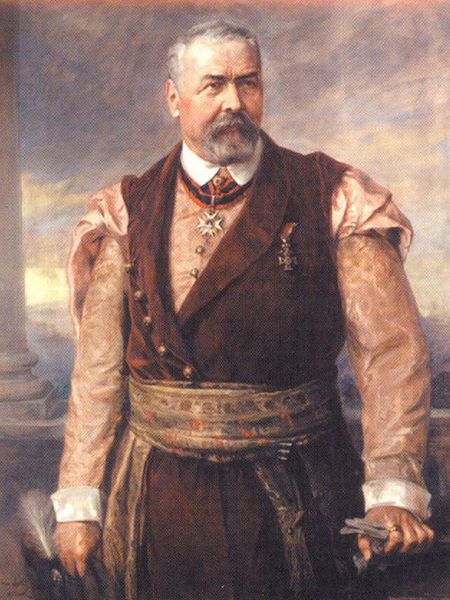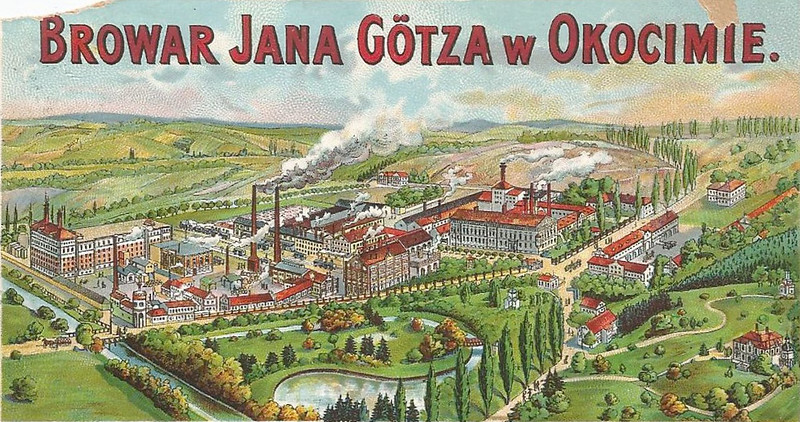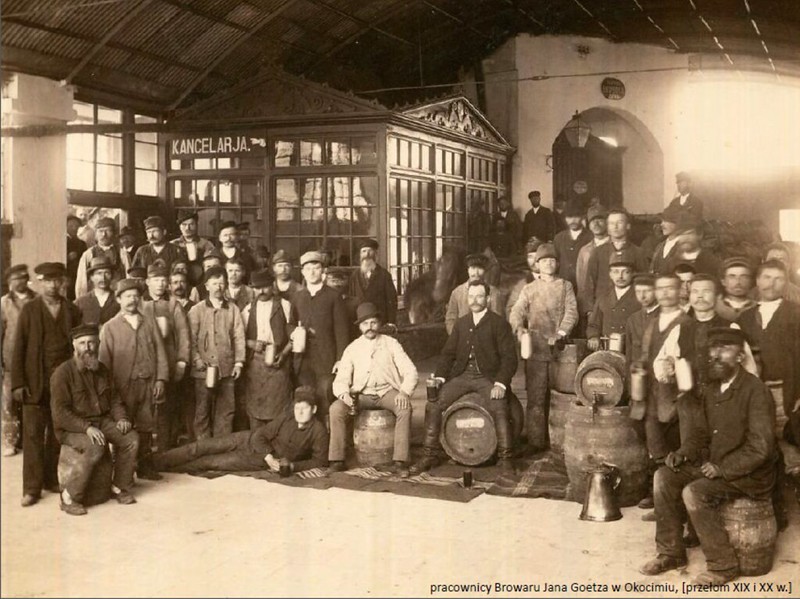
Today is the birthday of Johann Evangelist Götz (November 16, 1815-March 14, 1893). In Polish, his name is usually written as Jan Ewangelista Goetz. He founded the Okocim Brewery in 1845. Located in Brzesko in southeastern Poland, “his son Jan Albin expanded the family business, married a Polish aristocrat, and changed his name to Goetz-Okocimski. In 1945 the brewery was nationalized, then reprivatized in the 1990s. Carlsberg first acquired an interest in 1996, eventually acquiring full control in 2004.”

This short biography is from his Wikipedia page:
Johann Evangelist Götz was born to Anton and Josephine Götz. He attended the village school in his native Langenenslingen and middle school in Wilfigen, which he completed in 1830. He then worked in his father’s brewery and on the family’s farm. At the age of 18, as a journeyman brewer, he was employed in his cousin’s brewery in Hitzhofen. Subsequently, as a member of the brewer’s guild, he was obliged to travel away from his home region and establish himself as a brewer elsewhere.
He left Bavaria in 1834 and traveled around Germany and Austria, working in various breweries. He finally settled in Klein-Schwechat, near Vienna, where he obtained a position of “Cellarer” in a brewery of another cousin, Anton. After a year and a half, he was promoted. As an assistant to his cousin over the course of six years, he improved and modernized the brewery so that eventually it became one of the best-run brewing enterprises in Austria-Hungary. It was during that time that Götz introduced the then-new technique of bottom fermentation, which he would later utilize in his Okocim Brewery in Poland.

This is the entry from the Wikipedia page for the Okocim Brewery:
[Götz was] a German beer maker born in Wirtemberg together with Joseph Neumann, from Austria-Hungary, and local Polish noble, Julian Kodrębski. The first batch of beer was brewed on February 23, 1846. During the “Rabacja“, an Austrian-inspired peasant uprising in Galicia in 1846, directed at Polish nobility as well as affluent merchants, Götz barely escaped with his life. He survived thanks to help from local friends and the fact that the workers of his brewery stood up in his defense, certifying that his business provided good pay and decent working conditions. In turn, Götz helped to save the life of Julian Kodrębski, who had partly funded his brewery, by hiding him in woods on the banks of the Uszwica river in Brzesko, and providing him with food which was delivered over the course of ten days by workers from the brewery.
After the death of Neumann, Götz became the sole owner of the brewery. He modernized the enterprise and expanded it, adding a malthouse in 1875. In 1884 the brewery was visited by J. C. Jacobsen, the founder of Carlsberg brewery in Denmark.
After the death of Johann Evangelist Götz in 1893, the brewery was taken over by his son, Jan Albin Goetz. Jan Albin further expanded the family business, married a Polish aristocrat, and changed his name to Goetz-Okocimski. The Götz family quickly assimilated into Polish culture, became Polish patriots and engaged itself in Polish politics. Among other endeavors they funded a statue of Adam Mickiewicz, a gallery and the Juliusz Słowacki Theatre in Kraków, contributed money to buy out the Wawel castle from Austrian authorities. Jan Albin was also the president of the Koło Polskie (“Polish Circle”) in the Austrian parliament, and after Poland regained its independence a senator to the Polish sejm He built a private rail link between the brewery and the Brzesko rail station. As the richest person in Lesser Poland at the time he was also a philanthropist and a patron of the arts.

This account of the history of the Okocim Brewery is translated from Polish website:
John the Evangelist Goetz – the man from whom it all began.
At that time, Jan Goetz was a true visionary. Considered the father of modern brewing in Poland, he was one of the pioneers in the production of so-called Bavarian beer, bottom fermentation. The revolutionary nature of this method consisted in breaking with traditional forms of brewing beer, unchanged since the early Middle Ages. The new method consisted of aging at low temperatures of 7-12 º (in ice-cooled cellars) as well as bottom-up and back fermentation. This new species, called the lager, with a characteristic golden color and dense foam, beat the traditional types of beer on the head in terms of taste and allowed to store longer.
Although the founder of Okocim Brewery Jan Götz came from German Langenenslingen, he emphasized his belonging to Poland from the beginning. Soon for his involvement in the life of the local community, he received the nickname noble – Okocimski – and adopted the Polish name Goetz.
One of Jan Goetz’s principles was: best of the best. That’s how the best ingredients made beer, which brought Goetz fame and fortune. Goetz also kept in touch with other brewers, exchanging experiences and training in the art of brewing beer. At the end of the 19th century, Goetz met Jacob Christian Jacobsen, the creator of Carlsberg Brewery, who is only two years younger brother of Okocim.
The beginnings of Okocim Brewery
The history of the plant begins in 1845. It was then that Okocim with a small amount of money, sufficient only to build a small brewery, came then thirty-year-old Jan Goetz. Together with a partner, he began building a state-of-the-art brewery in Poland at that time. It was the quality of the beer brewed in it that made Goetz brewery very quickly become one of the largest in Poland. In 1846, the first bright full in Poland was brewed in Okocim. The first beer was only 7,500 buckets (1 bucket – approx. 60 l).
In the years 1846 – 1879, the volume of production in Okocim reached 24,000. hl. In the 1980s, three types of beer were introduced: Marcowe, Lager and Bock. The brewery, in particular, became famous for the latter, commonly known as bock. The brewery’s success gradually increased.
At the end of the nineteenth century, the brewery achieved an increase in production to 120 thousand hl. The beginning of the 20th century is already production at the level of 385,000 hl. In addition, the Okocim brewery from the beginning of its existence specialized in the production of oak barrels, not only for its own needs, but also for other breweries.

Okocim Brewery – beer for generations
In 1893, after the death of John the Evangelist, Okocim Brewery passed into the hands of his son, Jan Albin Goetz. In recent years before World War I, the brewery was at the forefront of the best of 1,200 breweries throughout the Austro-Hungarian monarchy. During the war, the Russian army forced the brewery to stop brewing for several months. After opening in 1915, the quality of beer dropped significantly. However, already in free Poland Jan Albin managed to restore Browar Okocim to the highest brand. During this period Okocimskie and Slodowe beers with the addition of sugar were brewed, as well as seasonal St. John’s beer.
After the death of his father, Antoni Jan Goetz became the owner of the brewery. Soon he launched a porter, which was sold in elegant, engraved bottles. The brewery’s prosperity was interrupted by the outbreak of World War II. Antoni Jan Goetz and his family fled to France from the approaching German army, and the brewery passed into the hands of the occupier and began producing beer for the army.When the Red Army approached Okocim, the German administrator, Karl Schroeder, ordered the dismantling of the basic machinery and equipment of the plant and taking them to Magdeburg. However, the train did not leave Silesia. The equipment was found and checked back by the brewery employees. The machines were quickly mounted to their former places, thanks to which the brewery began production in the same year.
After World War II, the brewery was expropriated and functioned as the State Brewing Company in Okocim, later renamed Okocimskie Brewing and Sweet Factory. Despite the lack of major modernizations, it was one of the most prosperous breweries in the country. It mainly brewed OK Pils beer, but also Caramel beer (formerly Słodowe).

The Goetz family – responsible employers, patrons of culture and art
The Goetz family was not only interested in beer – they supported culture, art and engaged in local life. Along with the brewery, the city also developed. New jobs were created. Thanks to the philanthropy of John the Evangelist, the first folk primary school, a neo-Gothic church, presbytery and library were opened in the vicinity of the brewery. In 1898, the Goetz took part in the buyout of Wawel from the Austrians, financially supported the construction of the Adam Mickiewicz monument on the Krakow Market Square, the construction of the theater Słowackiego and the opening of the gallery in the Sukiennice.
The Goetz family took special care of the brewery’s employees. In 1878, Okocim was one of the few workplaces to have its own credit and loan fund. Then a theater room was built, and a brass band was created.
Jan Goetz, as an avid social activist, founded a volunteer fire department, often leading the way in danger. He was awarded the Papal Order of St. New Year’s Eve and the Gold Cross of Merit with the Crown awarded by the emperor for participating in fire fighting around Okocim.
Jan II Albin Goetz Okocimski was an avid patron of the arts. In his collection he had canvases of artists such as Chełmoński and Malczewski. Family members were painted by, among others, Stanisław Wyspiański and Olga Boznańska.
Okocim Brewery today
Today, the Okocim brewery is undoubtedly a contemporary brewery, but drawing on its unique history. Not only when it comes to buildings, many of which remember the Goetz family, but above all in the approach to brewing beer and the principles that are passed down from generation to generation among Okocim brewers.

